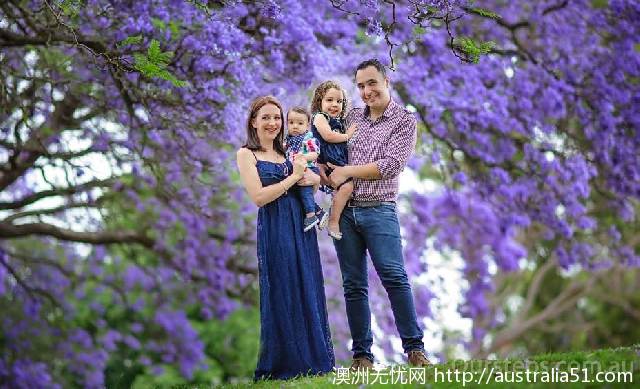How did the jacaranda tree "emigrate" to Australia?
It was a myth in Sydney that many years ago, hospitals on the northern coast of Sydney gave mothers the seeds of the jacaranda trees after giving birth to their children, allowing them to bring them home to plant seeds to commemorate the birth of the child.
The hospital encourages mothers to plant such beautiful and unique trees so that children and jacaranda trees grow up together and witness each other's growth.
This led to the northern and northern coastal areas of Sydney hundreds, thousands of blue-flowered couplets long forest, become a major local landscape.
However, it is doubtful whether the legend is true or not, because there is no such record at the Northern Coast Hospital, which has given mothers the seeds of the jacaranda tree to go back to planting.
At present, in Sydney, Xinzhou, jacaranda trees bloom everywhere, which is characteristic of Sydney in spring.
Jacaranda trees are not native and endemic to Australia. They are native to South America. How did they be introduced and widely planted in Sydney?
Jacaranda is now so famous, mainly because it blooms blue and purple flowers in the spring of the mainland of Australia.
This means that spring in the southern hemisphere is coming to an end and summer is coming.
It also means that middle school graduates rely on their entrance exam, HSC,VCE.
College students also know that when the blue-flowered couplets bloom, they have to take care of themselves and begin to study hard and prepare for the year-end exam.
The jacaranda (jacaranda), native to Brazil and Argentina, has more than 50 varieties of flowers in different colors.
The original name of Jacaranda is derived from the Native American Tupi word "yacarana" or "yacaranda", which is spelled in a j.
Although jacaranda has many colors, most people know that because of its color, it is blue, so it is called jacaranda.
Jacaranda was brought back to Europe by the Portuguese in the 18th century.
In 1818, the British collector Alan Cunningham also sent samples of jacaranda from South America back to England.
Alan Cunningham later became a botanist in the new state.
Another British colony, South Africa, began introducing blue-flowered couplets after 1820.
In Pretoria, South Africa, where jacaranda is widely grown, it is also known as the Blue Flower couplets.
According to Australian history, the first batch of jacaranda seeds arrived in mainland Australia around 1850.
The first successful blue couplet in Australia was planted in Walter Hill Botanical Garden in Brisbane around 1860.
In 1870, Alan Cunningham reported to the Queensland Congress that he had successfully planted blue-flowered couplets on both sides of George St Entrance.
Perhaps his most famous blue-flowered couplets were recorded by the painter Godfrey Rivers at the time.
He spent a very famous painting in 1903: under the white jacaranda trees in full bloom in Australia
The painting is currently in the Kunzhou Museum of Art.
Unfortunately, the famous blue-flower couplet fell in 1980 because of a typhoon.
Sydney's first documented jacaranda tree was planted in the Royal Botanical Garden in downtown Sydney in late 1850 or early 1860.
Many amateur gardeners also tried to plant blue-flowered couplets near their homes, but many were unsuccessful.
Because the seeds of these trees travel a long way from South America to Europe and then to Australia, they are dead.
In 1868, Guilfoyle's Exotic Nursery gardeners in Double Bay successfully produced the first native jacaranda seedlings in a very complex way.
He then began selling blue couplets to private buyers in his nursery.
Blue couplets are widely grown in New and Kunzhou in the late 19th and early 20th centuries.
Some district boards even sent the trees to residents to plant near their homes.
The most famous place in Xinzhou is the small town of Grafton..
Since 1879, they have widely planted blue-flowered couplets in the streets near Grafton through Parliament.
The Grafton Parliament plans to plant blue-flowered couplets on the local boulevard to shade and beautify the streets.
The local government and seed merchants and nursery owner Henry Volkers signed a contract to provide saplings.
After that, around 1920, it became a place where blue-flowered couplets bloomed on every avenue, and it was a very famous place.
Since 1935, the Grafton District Government has decided to hold annual blue-and-white couplets here.
Sydney's most famous blue-flowered couplets are the blue-flowered couplets at the University of Sydney.
The jacaranda tree is planted at the University of Sydney near its main quadrilateral sand-rock building.
(pity: the famous jacaranda tree at the University of Sydney fell overnight)
The first blue-flowered couplet at the University of Sydney was planted by German professor Eben Gowrie Waterhouse in 1927.
Eben Waterhouse is a famous camellia expert, but he thinks that if the university grows blue-flowered couplets, it can become a courtyard with ornamental plants that attract people to come here.
Students at the University of Sydney have a superstition about the jacaranda trees. If you haven't studied seriously before the jacaranda blossoms, you will fail in the final exam.
Grafton's blue-and-white couplets start this weekend until Nov. 6.

5.
